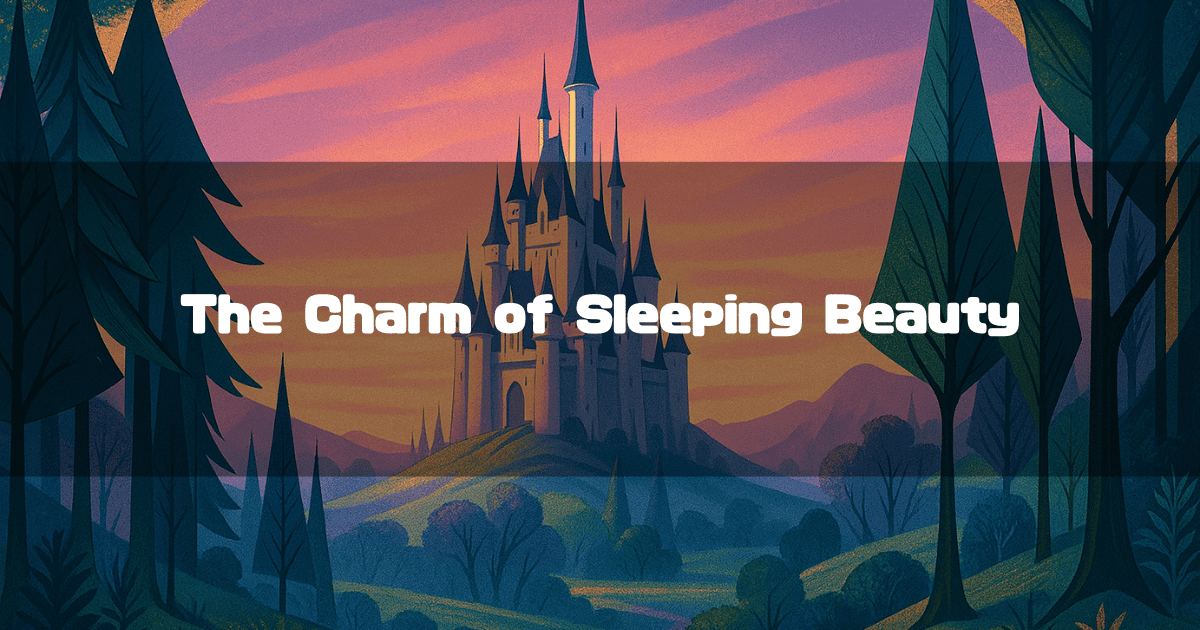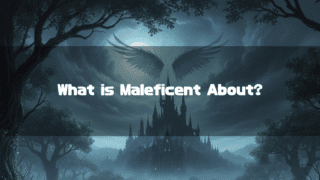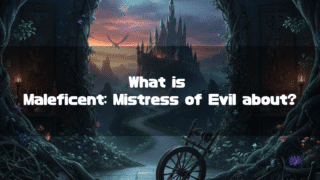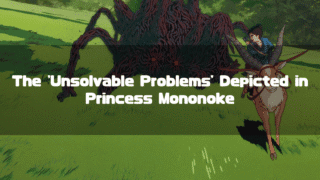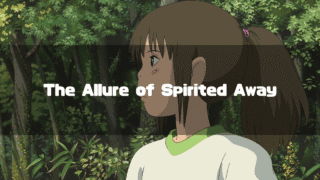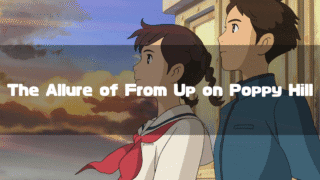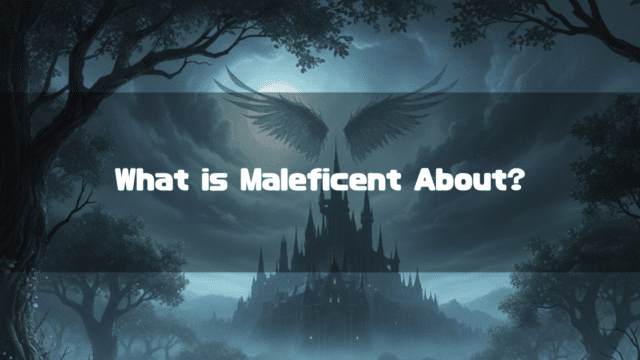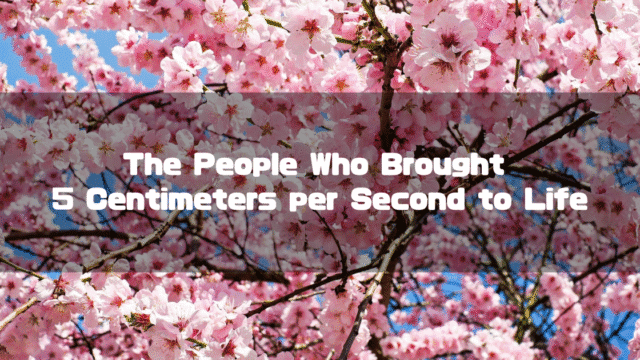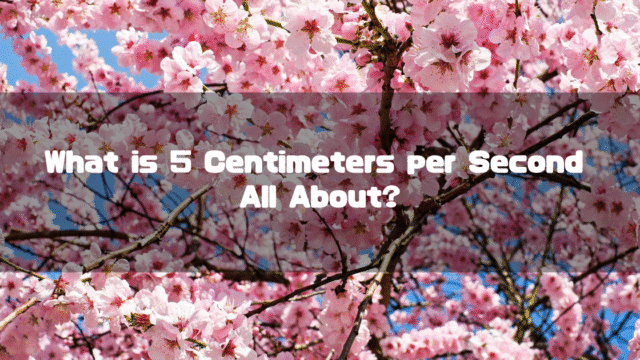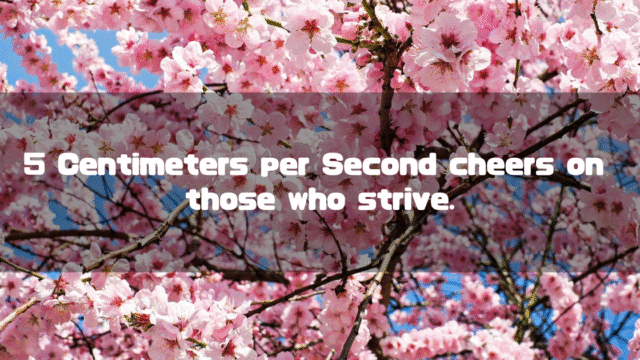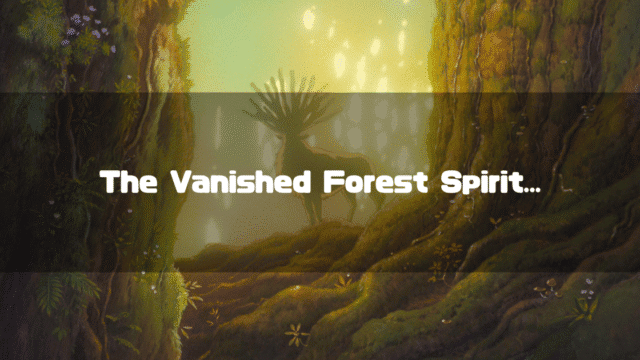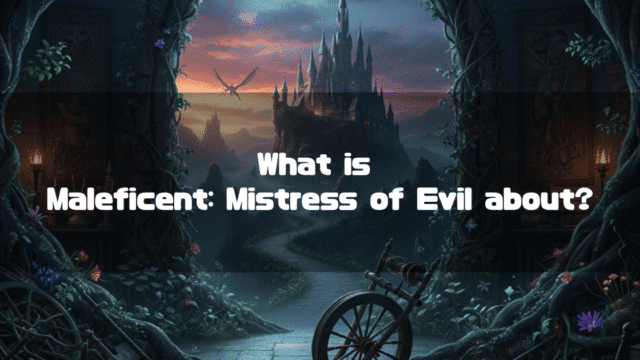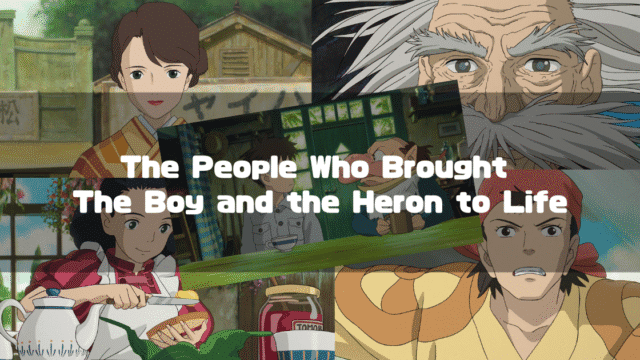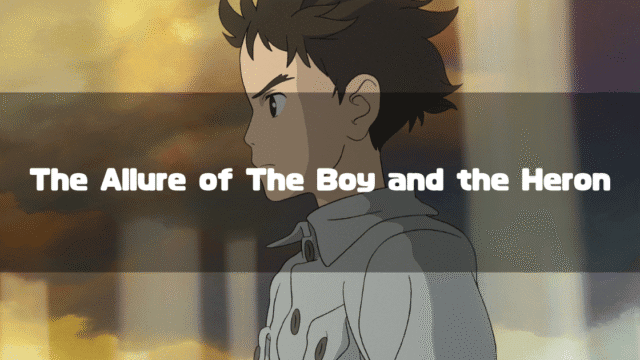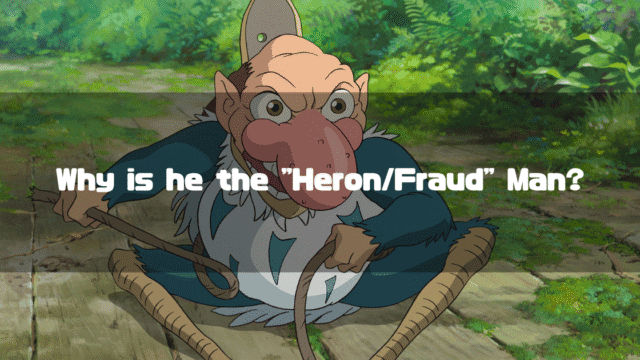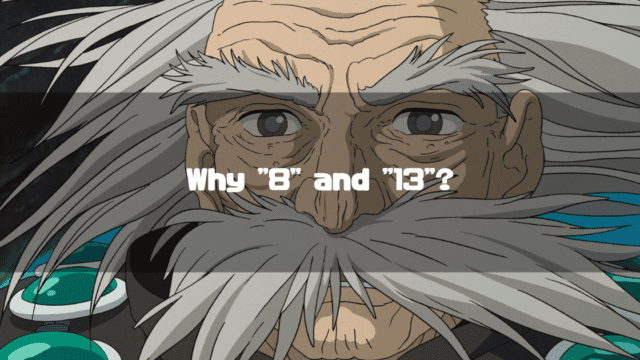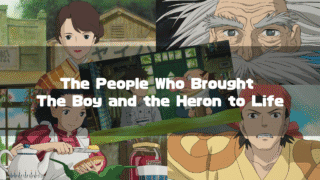Sleeping Beauty is an animated film released in the United States on January 29, 1959. The production company is Walt Disney Productions.
As stated on Disney’s official page, the original story is La Belle au bois dormant (The Sleeping Beauty in the Woods) from Charles Perrault’s collection of fairy tales Les Contes de ma mère l’Oye, published in 1867. However, the tale itself is an old European folktale. The Brothers Grimm’s version, Little Briar Rose, is also well-known, but their Grimm’s Fairy Tales was published in 1812 (Volume 1 in 1812, Volume 2 in 1815), meaning Disney’s source material predates the Grimms’ version.
However, the film features many original adaptations and omissions, so it is more natural to view the fairy tale as the “original concept.” Furthermore, it’s easier to understand if we consider it to be based on the more familiar Grimm’s fairy tale.
In this article, I will review the plot of Sleeping Beauty and explore what makes it so entertaining.
I may end up poking a bit of fun at it, but I believe that’s one of the ways to enjoy these classic films.
*This article is an English translation of the original Japanese article, 【眠れる森の美女(ディズニー版)】ネタバレあらすじとその面白さを考察-優れた作品にあふれる愛すべきツッコミどころと原作との違い-.
Let an AI walk you through the highlights of this post in a simple, conversational style.
-
A Story Boldly Adapted from the Original
The plot is based on Perrault’s fairy tale, but Disney added many unique elements not found in the original, such as “true love’s kiss” and the dragon battle with Maleficent. A key feature is the omission of the “100-year sleep,” a crucial element of the original. -
Maleficent’s Excessive Anger and the Captivating Depiction of Magic
Maleficent’s rage, casting a death curse simply for not being invited to a party, seems excessive. However, it serves as the driving force for spectacular and enchanting magic scenes. It can be interpreted that the expression of magic as animation took precedence over plot consistency. -
A Convenient Romance and Superb Visuals
The romance with the prince is more “love at first sight of convenience” than “true love,” making it a point to nitpick. However, the film’s greatest charm lies in its stunning visual expression, which more than compensates for this. It is a prime example of a work that captivates with visuals rather than its script.
Sleeping Beauty (1959) Plot Summary (Spoilers Included)
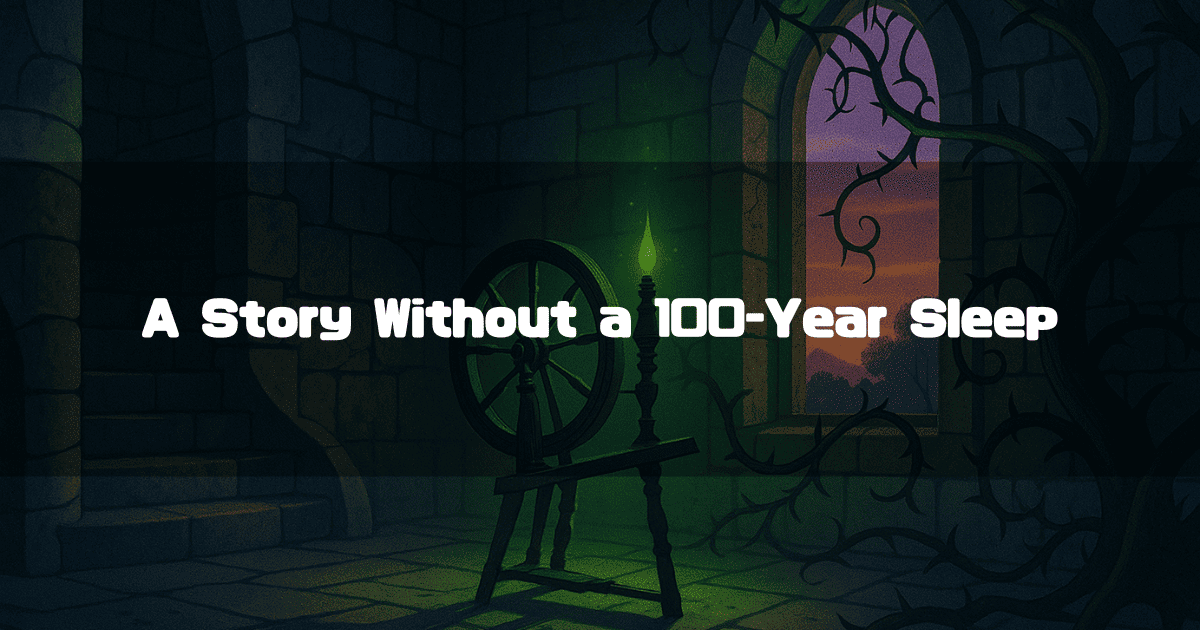
A Quick Summary, Character Map and Differences from the Original
The key points of the Sleeping Beauty plot are as follows:
-
Princess Aurora’s Birth and Maleficent’s Curse
The witch Maleficent, uninvited to the celebration of the long-awaited Princess Aurora’s birth, places a curse: “On her 16th birthday, she will prick her finger on the spindle of a spinning wheel and die.” However, a good fairy’s magic weakens the curse to: “She will fall into a sleep, to be awakened by true love’s kiss.” -
Encounter in the Forest and the Curse’s Fulfillment
Raised in the forest to escape the curse, the princess falls in love with Prince Phillip on her 16th birthday. However, upon returning to the castle, Maleficent’s magic leads her to prick her finger on a spinning wheel’s spindle, causing her to fall into a deep sleep. The prince, who could save her, is also captured by Maleficent. -
The Prince’s Showdown with the Witch and True Love’s Kiss
With the help of the fairies, Prince Phillip escapes the dungeon and triumphs in a fierce battle against Maleficent, who has transformed into a giant dragon. The prince reaches the castle and kisses the sleeping Princess Aurora, breaking the curse. The two are united, and peace returns to the kingdom.
Character Map
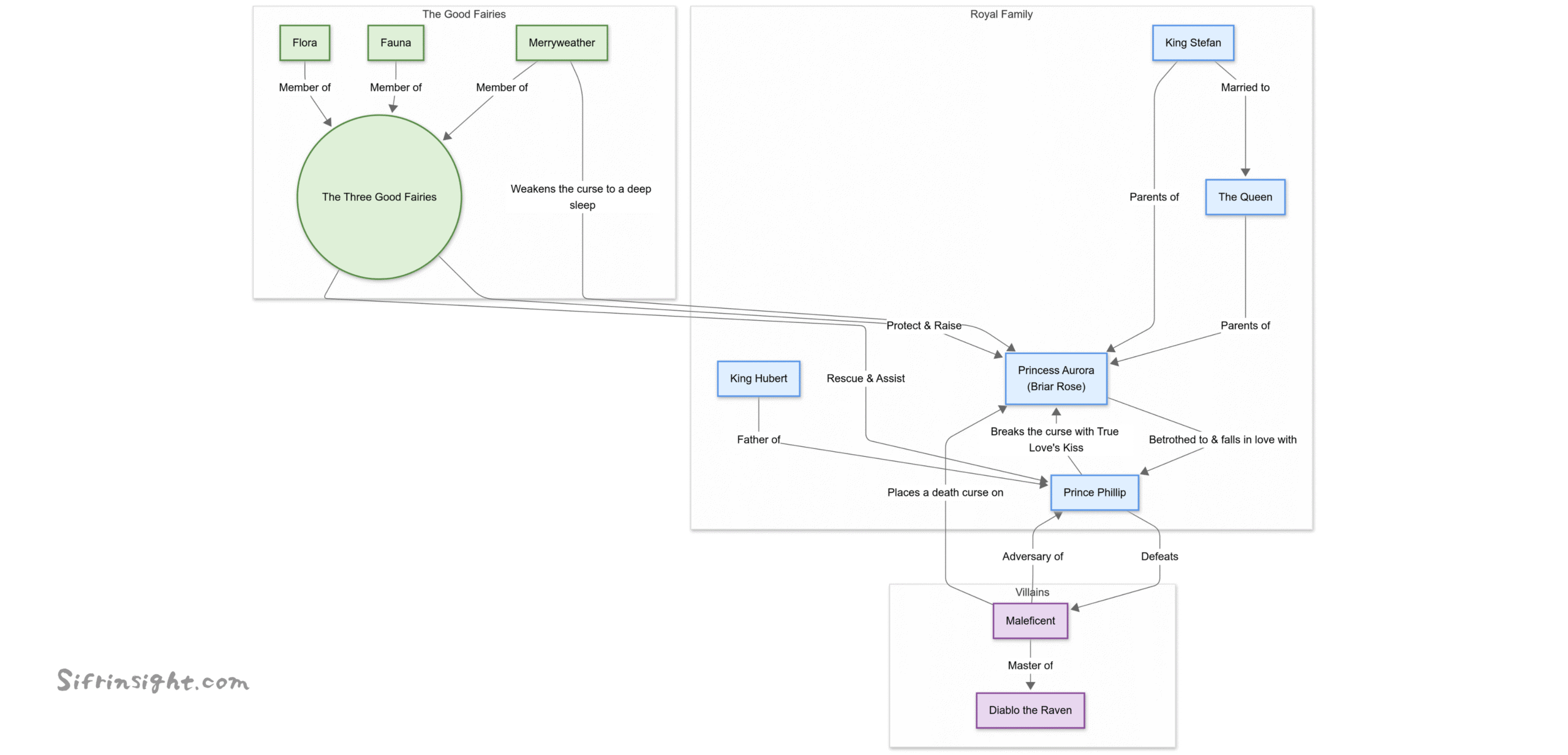
Next, let’s look at the differences from the Perrault version of the original story.
Differences from the Original Story
The original story of Sleeping Beauty is a fairy tale by Charles Perrault. The differences from the original are as follows:
| Point | Perrault’s Version | Disney’s Version |
|---|---|---|
| Fairies and Maleficent | Seven fairy godmothers are invited from all over the kingdom. An old, uninvited fairy casts the curse. | A conflict between three good fairies (Flora, Fauna, Merryweather) and the evil witch Maleficent. |
| The Curse | The curse is to “die by pricking her finger on a spindle.” A young fairy weakens it to a hundred-year sleep (no mention of a kiss). | The curse is to “die before the sun sets on her 16th birthday.” Merryweather weakens it to a sleep, to be broken by “true love’s kiss.” |
| The Princess’s Upbringing | The princess is raised in the palace. There’s no plot of hiding her in the forest as a commoner. | The three fairies raise her in the forest. The princess grows up under the name Briar Rose. |
| The Spinning Wheel Scene | She meets an old woman spinning in a castle tower and, out of curiosity, pricks her finger on the spindle herself. | Maleficent magically lures her to a spinning wheel created by a green light. The princess pricks her finger against her will. |
| Scope of the Sleep | Not only the princess but everyone in the castle—people, animals, even the fire and spits—fall asleep at the same time. | It was the fairies who put the castle’s inhabitants to sleep. |
| Relationship with the Prince | No prior meeting or engagement. A hundred years later, a prince arrives, passes through the thorns, and meets her for the first time. | A political engagement was planned since childhood. They first fall in love in the forest without knowing each other’s identities. |
| The Awakening | She awakens when the time is up and the prince arrives (no kissing scene). | Awakened by Prince Phillip’s kiss, which breaks the curse. |
| The Climax | No major battle scene. The story concludes quietly with the prince’s arrival and her awakening. | Maleficent transforms into a dragon, and the prince slays her with the “Sword of Truth.” |
| Age and Time Limit | The princess is about fifteen or sixteen when the accident occurs. There is no explicit deadline like “by sunset.” | It is explicitly stated that the curse will activate “by sunset on her 16th birthday.” |
| Dealing with Spinning Wheels | The king issues a proclamation forbidding spindles. | King Stefan has all the spinning wheels in the kingdom burned. |
| The Prince’s Ordeal | No particular abduction or imprisonment. | Maleficent abducts and imprisons him. The fairies rescue him. |
It’s particularly noteworthy that in the original story, there is no scene where she is awakened by a kiss. This element likely originates from the Grimm’s fairy tale Little Briar Rose.
Furthermore, the “100-year sleep” is completely omitted, and she is awakened by the prince’s kiss a relatively short time after falling asleep.
Now, let’s take a more detailed look at the plot of Disney’s Sleeping Beauty.
Princess Aurora’s Birth and Maleficent’s Curse
Long ago, in a certain kingdom, the long-awaited Princess Aurora was born to King Stefan and his queen. To celebrate the princess’s birth, a grand feast was held at the castle, to which King Hubert and Prince Phillip from a neighboring kingdom were also invited. The two kings planned to announce the engagement of Princess Aurora and Prince Phillip, hoping to unite their kingdoms in the future.
Three good fairies, Flora, Fauna, and Merryweather, also attended the feast to bestow gifts upon Princess Aurora. Flora gifted her with “beauty,” and Fauna with “the gift of song.” However, just as Merryweather was about to give her gift, the evil witch Maleficent, resentful for not being invited, appeared and placed a terrible curse on the princess: “Before the sun sets on her 16th birthday, she shall prick her finger on the spindle of a spinning wheel and die.”
As sorrow filled the castle, Merryweather became the last hope. While she couldn’t completely undo the curse with her magic, she succeeded in weakening it, changing it from “death” to “a 100-year sleep, to be awakened by true love’s kiss.”
A Secret Life in the Forest
Fearing for his daughter’s safety, King Stefan ordered all the spinning wheels in the kingdom to be burned. Meanwhile, the three fairies devised a plan to protect the princess from Maleficent by raising her deep in the forest until her 16th birthday. With heavy hearts, the king and queen agreed to the plan and entrusted Princess Aurora to the fairies. To hide her identity, the princess was to be raised under the name Briar Rose.
During this time, Maleficent had ordered her minions to search for Princess Aurora, but for 16 years, they failed to find her. The foolish reason for their failure was that they had been searching for a “newborn baby” all along.
A Fateful Encounter and the Curse’s Fulfillment
On her 16th birthday, Princess Aurora (as Briar Rose) was singing in the forest when she met Prince Phillip, who happened to be passing by. Unaware of each other’s true identities, they fell in love at first sight and promised to meet again that evening.
However, upon returning home, Aurora was told her true identity by the fairies and that she was already betrothed. The princess was deeply saddened by the sudden separation from the man she loved and the fate of having to marry a prince she did not know. With a heavy heart, she accompanied the fairies to the castle.
But Maleficent’s crow had spotted the grown Princess Aurora. As the princess grieved alone in the castle, Maleficent appeared, lured her with magic, and led her to a spinning wheel created from a green light. Against her will, Princess Aurora pricked her finger on the spindle and, just as the curse foretold, fell into a deep sleep.
The Prince vs. The Witch
To stop Prince Phillip, the only one who could awaken Princess Aurora, Maleficent abducted him and imprisoned him in her castle’s dungeon. She devised a cruel plan to keep him locked away for 100 years, only to release him as an old man to awaken the princess with an old woman’s kiss.
However, the three good fairies came to Prince Phillip’s rescue. With the aid of their magic, the prince escaped the castle. Enraged, Maleficent transformed into a giant dragon to block his path, but after a fierce battle, Prince Phillip succeeded in defeating the dragon with the Sword of Truth.
True Love’s Kiss
Upon reaching the castle, Prince Phillip gently kissed the sleeping Princess Aurora. The curse was broken, and the princess awoke from her long slumber. The entire castle came back to life, and their love saved the kingdom.
Afterward, Princess Aurora and Prince Phillip were married amidst the blessings of their people and lived happily ever after.
Sleeping Beauty (1959) An Analysis of Its Charm – The Brilliance of a Visual Masterpiece Seen Through Its Plotholes
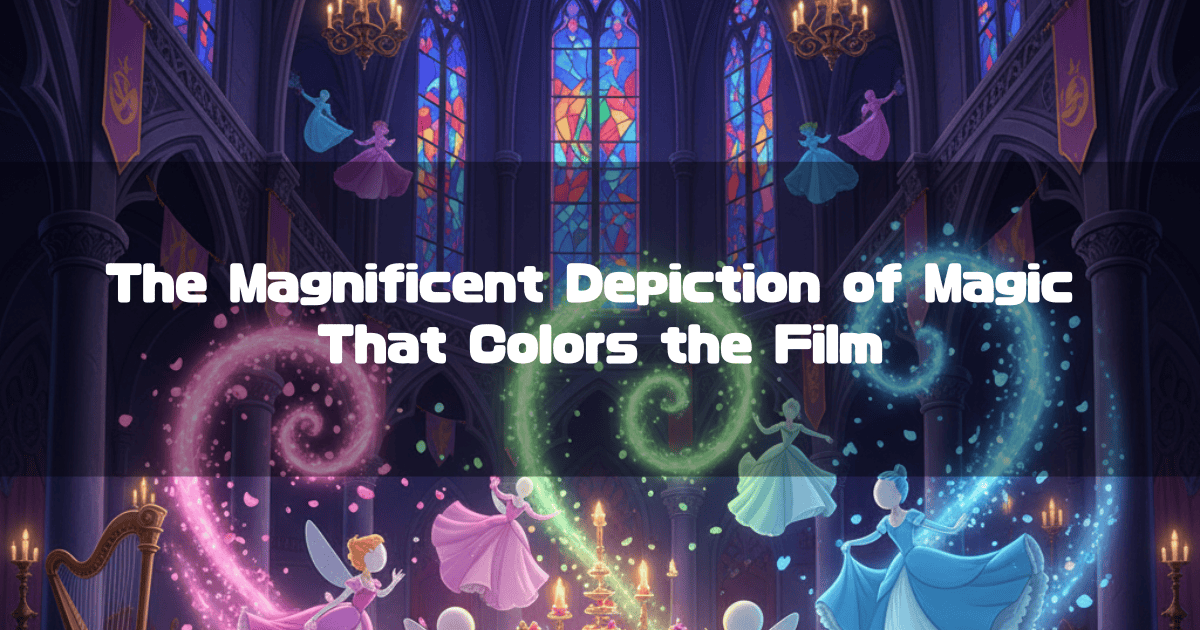
The Adorable Animals
It’s no exaggeration to say that one of the greatest charms of Sleeping Beauty is the cuteness of the forest animals that Aurora grew up with.
This isn’t unique to Sleeping Beauty but is a common theme in Disney animation in general—the animals are simply adorable.
The unique, smooth animation style of Disney films from that era is a perfect match, and it feels like they have perfectly captured “the way we wish animals would be.” I’d love to live surrounded by animals like that.
Of course, real animals are probably not so endearing or so willing to be close to humans, but for some reason, we humans seem to wish they were. I think this不思議な (mysterious) desire is wonderfully realized through the animation.
The Maleficent is Way Too Angry Problem
Now, to poke a little fun, perhaps the biggest point to nitpick in Disney’s Sleeping Beauty is that Maleficent gets far too angry.
She places an outrageous curse—a deep sleep—on Princess Aurora simply because she wasn’t invited to the birth celebration (the reason for cursing the princess is the same in both the Perrault and Grimm versions). Of course, it’s understandable that she’d be upset, but it seems like an excessively harsh curse to place on a newborn child.
Naturally, in the original story, the most crucial element is the situation of “a princess who has been asleep for 100 years,” so it’s understandable that the reason for it is a bit simplistic.
However, in the Disney version, not only does the princess not sleep for 100 years, but she is awakened by the prince’s kiss almost immediately after falling asleep. With the central gimmick of the “100-year sleep” completely omitted, the imbalance between Maleficent’s anger and the curse she casts becomes much more noticeable.
But, looking at it from another perspective, we could also argue that what Disney wanted to portray was something entirely different.
This is just speculation, but perhaps the most important aspect of that film was the “depiction of magic itself.”
When you focus on the portrayal of magic with that in mind, you realize just how captivating it is. Even for us, who are familiar with modern animation (or perhaps because of it), it’s easy to be impressed and think, “Wow, that’s amazing!”
The character movements and animation are excellent to begin with, but the magic is depicted as something truly mysterious, powerful, and eerie. As a result, the film is “a work that’s enjoyable to watch again and again, even when you know the story.”
While I do think Maleficent’s anger is excessive, we can position it as being for the sake of the charming “100-year sleep” gimmick in the original story, and in the Disney version, it serves the purpose of “allowing for many depictions of magic.”
Prince Phillip: A Love Too Convenient to be True
Sleeping Beauty is supposed to find its “beauty” in the story of a cursed princess awakened by true love’s kiss, but doesn’t it seem a bit too convenient to be called “true love”?
Having Prince Phillip and Princess Aurora meet once in their childhood is a clever structural choice that helps create the “destined couple” narrative. However, their first real contact is when they meet in the forest when Aurora is 16.
For Phillip, it was essentially “love at first sight” with the beautifully grown Aurora.
To be blunt, it was solely because of Aurora’s appearance, and I think it’s fair to say that this portrayal is quite different from what we generally mean when we say “true love!”
Watching the film, one can also imagine that Prince Phillip was not happy about the arranged political marriage that was decided for him and felt a desire to escape from reality (after all, he had to become king one day). In that context, meeting a beautiful woman like Aurora might have been a good excuse to run away from his responsibilities.
Ultimately, this suggests that even the “love story of Aurora and Phillip” is treated as a minor element in this film.
As mentioned earlier, what this animation truly wants to depict is “magic.” In the face of the ambition to fully portray “magic” as an animated expression, the need to depict “true love” likely faded away.
And yet, because it is such excellent animation, it’s still an enjoyable film.
Perhaps this work is a great example of how the essence of animated and visual media lies not in the script or story, but in the visual expression itself. In that sense, the narrative “flaws” inherent in fairy tales might not necessarily be a bad thing.
The above is my personal analysis of what makes Sleeping Beauty so interesting. The plot holes seem to stem mainly from the fact that it’s based on a so-called “fairy tale,” and trying to fix them all would likely cause issues with the runtime (three hours might not even be enough).
I believe the narrative flaws I’ve pointed out here are skillfully addressed in the later Disney film Maleficent. However, since the protagonist is Maleficent and the interpretation is drastically changed, it’s better to consider it a separate work. Still, it might be interesting to watch Maleficent with the mindset of seeing how it resolves every single plothole found in Sleeping Beauty.
That’s all!
About the Author
Recent Posts
- 2025-10-21
Indiana Jones and the Dial of Destiny(2023): Full Synopsis & Analysis: Indy’s True Motive and the Enigma of Helena - 2025-10-15
Indiana Jones and the Dial of Destiny(2023):Historical Background-WWII, the Real Dr. Schmidt, the Siege of Syracuse, and the Antikythera Mechanism - 2025-10-08
Why Does Children Who Chase Lost Voices Feel So Ghibli-esque? [Makoto Shinkai’s “Tale of Farewell”] - 2025-10-07
5 Centimeters per Second: Characters, Voice Actors, Character Analysis and Character Map - 2025-10-06
5 Centimeters per Second: Full Synopsis, Analysis, Ending Explained & Character Map (Spoilers)

